|
Ros
Davies' Co.
Down, Northern Ireland Family History Research Site
© Rosalind Davies 2001 Permission granted to reprint research for non-profit use only |
Tullynakill Parish
| Church ruins & Church of Ireland | Old Lisbane Post Office | Mahee Island | Nendrum Castle | Sketrick Castle |
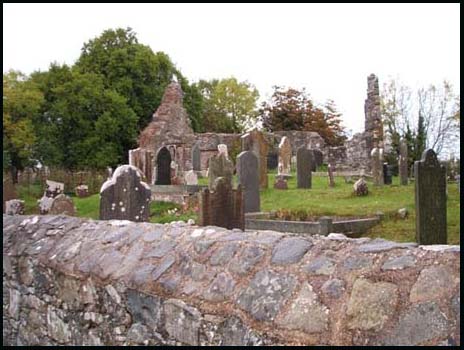 |
|
||
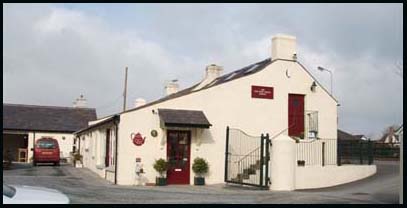 |
|
|
in Strangford Lough
3km W of Ardmillan
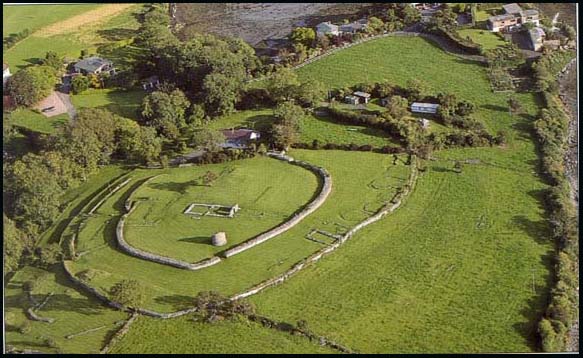 |
 |
 |
||
| View today | Aerial reconstruction of monastic site | Ancient monastic sundial |
|
Mahee is a large island, 3 km NE of Killinchy on the western shore of Strangford Lough. As well as farms, and a ruined Norman Mahee Castle (see photo below) there is the ruins of an early Christian monastic site on the island It was built in 5th century by St. Mochaoi (St. Mahee). References to the monastery begin
in the 7th century and continue until a fire in 976, perhaps a Viking
raid, when the abbot was burned in his house. In the late 12th century
a small Benedictine monastic cell was founded on the site, but by 1306
the parish church was here, abandoned in favour of Tullynakill church
on the mainland in the 15th century. There is an article in Lecale Miscellany 2002 about an iron axe head & bronze ringed pin. |
| References; V7 p 124 OSM : HMNI p105 ; O'L V1 p 349, 353 & B p 154; TOOC p20; LM 1996 p19 |
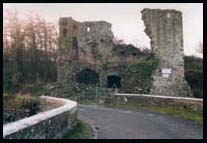 |
|
|
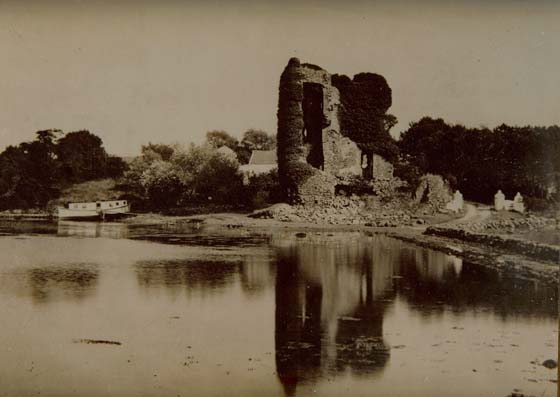 |
Sketrick Castle is situated on the western extremity of Sketrick Island which is in Strangford Lough and is now joined to the mainland by a causeway. It is off Ballydorn townland in Killinchy parish but was aligned to Ardkeen parish in the old days for taxation purposes. There is a raised footpath from the mainland
and the strait of water separating the two is nearly dry at low tide.
Mentioned in written sources of 1470 as having been involved in warfare.
A great army was lead by the O'Neill into Clannaboy to assist MacQuillan.
They took Sketrick Castle and was given to MacQuillan for safe keeping.
In 1833 is was described as a plain, stone building about 40 feet high, oblong in form and did not appear to have any flanking towers or outworks attached to it. The entrance faces west, being opposite the ford across the strait. The castle was not habitable then, being unroofed and open from the top to the ground. It stood complete until wrecked by a storm in 1896. The locals say that the Danes (Vikings) built it but it looks more like an Anglo- Norman construction. The Montgomery Manuscripts states;" Other
ancient family of the Savages is that of Archin (Ardquin ) Castle. It
is of good account and hath another as they called Sketrick, the oldest
of them all..." In the 1901 Census only one family called
Montgomery lived here. Here is Shannon Lengkeek's account;- My great-great grandfather Hugh Montgomery (estimated date of birth as 1844) and his wife MaryAnn (nee: Dalzell), owned Sketrick Island and Sketrick Castle Ruin. In 1901, there was only one house on the island. There was a second house added between 1901 and 1911. The family also owned Islandmore, also in Strangford Lough. Hugh Montgomery's house on Sketrick is now a pub called Daft Eddies. In 1901 there were two homes on Islandmore, occupied by two of the son's of Hugh Montgomery and his wife MaryAnn's (nee: Dalzell) and their families. In one house there was Samuel Montgomery and his wife Anna (nee: Gilmore) and their children. In the second house was David Alexander Montgomery and his wife also named Anna (nee: Savage). At one point, Samuel Montgomery was attending school in Scotland to become a veterinarian but had fell ill and had to return from his studies. The family attended the Kilinchy Presbyterian Church. By the time of the census in 1911, a second home was on Sketrick island and David Alexander and his wife Anna (nee: Savage) and children moved from Islandmore to Sketrick. Samuel Montgomery and his wife Anna (nee: Gilmore) remained on Islandmore until they immigrated with their children to Canada in 1913; they left behind a legacy in order to accompany the siblings of his wife Anna (nee: Gilmore) and to set down roots in western Canada. At that time, Islandmore was sold by Samuel Montgomery and his wife Anna (nee" Gilmore) to Samuel's brother Robert Montgomery. Robert's son Hugh later sold the Island; Hugh and his wife never had children and Hugh predeceased his wife. Robert still has a living daughter Elizabeth Horner living nearby. Samuel has descendants living in Canada, from his daughter that was born on Islandmore, Anna Rolston (nee: Montgomery). Note: the death certificate of Robert Montgomery's (son of Hugh and Mary Ann) states his date of birth as September 7th, 1888 but church records show the date of birth as October 2nd, 1889 and baptism on May 6th 1890. I had verbal confirmation from his living daughter in 2014 that his date of birth had been uncertain at the time of his death. Also, first names were usually reused in each generation: Samuel, Hugh, Robert, William, James, David, Elizabeth, Anna, and Flora. The lands have been ownded by Montgomery's since the 1600s and had
been passed down from Viscount Hugh Montgomery as indicated in the "Estate
of Hugh Montgomery" (in 1629) |
| This lovely old postcard was kindly sent by Michael Taggart | |
 |
|
| Sketrick Castle in 2000 | References;V7 p 3, 89 OSM; HMNI p 108; O'L V1 p 346; PNNI V2 p 25; Inv 2003 p51; POD ; Shannon Lengkeek |
by Ros Davies